Feature Interview with Gil Hanse
January, 2000
After working with fellow Cornell alum Tom Doak at noted courses like High Pointe and Stonewall, Gil Hanse started Hanse Golf Course Design in 1993. With the 1998 opening of the 18-hole Craighead Golf Links for the Crail Golfing Society, Gil became just the third American architect to build a course in Scotland. And build he did, spending nearly a year living in the home of golf, ‘hand crafting’ the new links for world’s seventh oldest golf club. His other design efforts, aided by a talented team that includes former Merion pro Bill Kittleman, are the private Inniscrone Golf Club in Avondale, Pennsylvania (1999), Tallgrass Golf Club in Shoreham New York (2000 opening), and South Fork Country Club in Amagansett, New York (new 9 opening 2000).
Hanse has also established himself as a top restoration specialist, with an impressive resume of work: Merion’s East Course, Kittansett Club, Tillinghast’s Fenway GC in Scarsdale, New York, Plainfield CC, Plainfield, NJ, Century CC, Purchase, NY and two other Pennsylvania classics: Lancaster Country Club and Gulph Mills Golf Club. Gil is currently spending most of his time in Brookwood, Alabama, building The Capstone Club, a new private club for the alumni and golf team at the University of Alabama. This spring he starts work on Applebrook Golf Club near his home he shares with his wife Tracy and three children in Malvern, Pennsylvania. And this fall, on Southern California’s 18-hole public Rustic Canyon Golf Club in Moorpark is slated to begin construction.
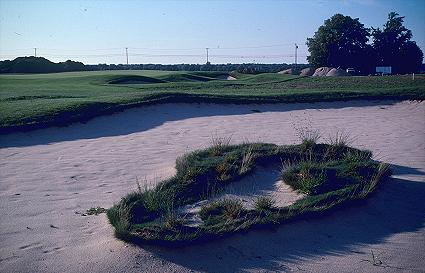
Gill's Tallgrass in New York is opening this year.
1. Is there a particular feature that is generally considered antiquated (cross bunkers, punchbowl greens, etc.) you think is missing from course design today?
While the two you have mentioned certainly merit more use, I have become fascinated with an antiquated feature that hardly ever receives attention. It may not even be considered a feature in most people’s minds, but I think it warrants attention. I truly love when architects use natural landforms as a hazard on a hole. By this I mean the use of a ridge, hollow, swale, or crease in the ground to promote strategy. Very often it is an improved line of sight that is the reward. If a player can avoid the landform, then he is often rewarded with a clear line of sight to the hole, or a more fruitful angle from which to attack the green site. If the player happens to roll into the hollow, or winds up behind the ridge, then they have a shot that is more difficult on the psyche, while not being technically much more difficult than a shot played from the same distance with a clear sight line. If these features can be highlighted by incorporating them in the fairway (so that the hopefully firm and fast conditions) will exaggerate the plight of the ball, they can be a very dramatic feature.
I find this subtle form of hazard, as opposed to a pond, stream, or even a bunker, can provide for a great deal of interest and variety in a round of golf. If you take it back far enough, it is an extension of the true nature of links golf, where the uneven nature of the lie, stance, and sight (or lack thereof) are truly dependent on the vagaries of the natural landscape. In this day and age, there are not many architects who would contemplate creating a situation where someone’s vision might be partially obscured on a hole (how could it be the signature hole if you cannot see it). I think that the use of natural landforms to subtly penalize a golfer is a great throw back to lay of the land architecture. A few examples that pop into mind are the fairway contours on the 16th Hole at The National, 13th Hole at Pine Valley (left side), several of the holes on the Back Nine at High Pointe, 7th Hole at East Hampton GC, 12th Hole at Inniscrone, and I can imagine with some thought we could all come up with a much more thorough list.
I also feel that these types of hazards can be used to varying degrees in keeping with the wayward nature of the shot. A player who has nearly pulled off a good shot could perhaps just not see the putting surface, a bit further away, and only the flag is visible, way off line and the shot is blind into the green. The same can be used if length instead of line is the factor on the hole, from nearly long enough to short, with the commensurate penalty for each shot. The final comment on the use of this feature is that Mother Nature provides these types of landforms in an infinite array of sizes, shapes, and character. Creating a situation where they can be used with imagination, and in a fresh way on any site that possesses them. Hopefully, architects that can use them in resourceful ways will be blessed with those sites.
2. What three attributes must a course possess in order to draw you back again and again, year after year?
- Character – I think that a course should have a unique character to it, something that sets it apart from the run of the mill golf course. This character can be found in the features, playability, clubhouse, property, and the truly great courses have character in all of these areas. Personally, I am drawn to simplicity in nature, and courses with a rustic charm. I think that great golf courses and clubs are comfortable with themselves. They feel no need for pretence or showmanship, it is simply a take it or leave it atmosphere. As for the trappings of the golf course, the more unkempt and rustic in nature, the better I like it. These courses are much more likely to be interesting to look at and to play.
- Interest – I think that this is a key word that is missing from the vocabulary of most golf course reviews. A course has to hold your interest in order to want to play it again and again. Interest should come in the form of all aspects of the architecture of the course. You should have to play interesting, and perhaps unusual, shots into holes from different angles and from different lies and stances. The putting surfaces should have interest in their contours, and the bunkers in their vegetation, appearance, and location. In my opinion, variety is a key element in creating the interest of any course. Subtlety is another component in this respect, in that courses that capture your attention and imagination often have subtle touches that are not readily apparent the first time around, and hopefully they may not be apparent for many more times. I firmly believe that subtle touches can add a tremendous amount of complexity to a course, without it appearing overdone. I think I may have described The Old Course in this last paragraph.
- Fun – It is after all a game, and a course should be fun to play. Fortunately for most of us this fun can be derived from an appreciation of the above statements.
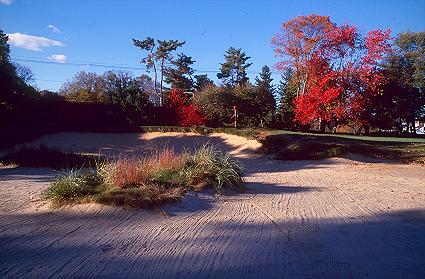
Merion embodies character, interest and fun.
3. Why don’t the ‘other’ Philadelphia area courses (ie. not Pine Valley and Merion) receive more recognition?
I believe that the Philadelphia area is second only to the NY metro area as far as quality of golf courses is concerned. This may not even be a fair comparison in that the NY metro area draws from a much larger and more diverse area (Westchester, Long Island, and northern New Jersey) whereas the Philadelphia region is much more compressed. We are certainly blessed with a large number of great ‘second tier’ clubs. Even in Philadelphia, when golf courses are discussed it is always prefaced with ‘aside from Pine Valley and Merion’. I also think that having two of the greatest golf courses in the world within such close proximity, tends to detract from the supporting cast.
The other factor that I think is at play in Philadelphia is the William Flynn factor. Philadelphia has tended to be very parochial when it comes to the design of its golf courses. Toomey and Flynn were responsible for the vast majority of the ‘other’ courses in Philadelphia. During the 50’s and 60’s, the Gordon’s and George Fazio designed most of the courses to come on line in Philadelphia during this period. More recently Tom Fazio has returned to his roots, and we have enjoyed a good reputation in our adopted home town. This factor I think has limited the variety of courses in Philadelphia, which may have hurt the overall perception of the courses in this town. While Flynn built many solid designs, none could be called spectacular in the vein of Pine Valley or Merion. This leads to a core group of solid ‘second tier’ clubs that cannot fail to impress with their design integrity, and they provide the depth of quality in Philadelphia that is lacking in other metropolitan areas.
My Top 5 ‘aside from Pine Valley and Merion’ are
- Rolling Green – great set of greens and par 3 holes.
- Gulph Mills – loads of character from Mr. Ross and Mr. Maxwell
- Manufacturers – cut down some trees and this would go up.
- Lancaster – great setting with more great greens from Mr. Flynn.
- Merion West – Bill Kittleman says that there is more architecture in this course than on the East.
4. If time or expense weren’t considerations, which five courses would you most like to see for the first time?
- Sand Hills
- Royal Melbourne
- Chicago Golf Club
- Kingston Heath
- Hirono
5. Tell us about the special challenges involved with building the links course at Crail. What aspect of the final design pleased you the most?
One of the most interesting challenges we had to deal with at Crail was the emphasis on the archaeological importance of the site. Running through a section of the site is The Danes Dyke, no jokes please, it is a wall that was erected by the Danes and it precedes the birth of Christ. Adjacent to the course is the ancient harbour of Crail, which is one of the oldest harbours in Scotland. The Vikings would land in this harbour and then set forth to rape and pillage the Fife countryside. After some bruising battles, they finally erected a wall as a last line of defense, before getting in their boats and setting sail for home. Needless to say, this is a very important archaeological site, and one that is remarkably preserved. Our challenge was to route the golf course on a small piece of property (114 acres), and use this wall as a strategic feature because their was no way to avoid it. I think that we were very successful given the limitations of the site, in routing an interesting course. We emphasized the change of direction (due to the ever present winds), and we wanted to get to the North Sea on the outward nine as well as the inward nine. I also think that we used the wall in several creative ways, as well as in varied ways on the holes that it intersects. It does create a few blind situations, however, the Scots are not as squeamish as we are about blind shots, and I thought that this might be a great opportunity to incorporate the element of blindness into one of our courses.

With the archaeological interest in the site, the Club had to hire a full time archaeologist to follow us around site. So whenever, my associate Rodney Hine, or I went to shape a green or bunker, this guy had to sift through the dirt before we could proceed with final shaping. It worked our okay, because he was a good guy, and oddly enough he was Danish. I am very pleased with the way the bunkers have turned out. Rodney and I went into the project with the goal of revetting (stacking sod) on all of the bunker faces, and we accomplished that goal. We also wanted to be a bit more artistic with the bunker shapes, and we were able to change the angle of the revetting in order to accomplish that look. Walter Woods, the former greenkeeper of the Old Course, came down every now and again to give us some advice, and he was quite keen on our bunker shapes. Jim Finegan also gave us some nice complements on the bunkering, stating that it was ‘the nearest thing to Muirfield bunkering, apart from the great course itself.’
The most special parts of the project were having 6 months in Scotland with my family to concentrate solely on this course. It is unfortunately a pleasure that is becoming harder to accomplish. We also had the great fortune of being 10 miles from St. Andrews, so whenever we would brain lock on ideas, we could hop in the car and go to the Old Course and come back with plenty of ideas and inspiration. I also found it to be really neat to have designed a course for a Club whose other course was designed by Old Tom Morris. Having my name next to his is truly an amazing honor. Our time at Crail will always hold such great memories, it is hard to contain them to a few paragraphs.
6. What five holes (from different courses) do you wish you could say you designed?
- 13th at North Berwick
- 8th at National Golf Links
- 10th at Riviera
- 8th at Crystal Downs
- 7th at San Francisco Golf Club
7. What are your thoughts on The Engineers Club? Where would you rate the work of Herbert Strong?
Our thoughts on Engineers run very strong and very deep. Unfortunately they have been singed with frustration over the years. We have had a very long relationship with the club, and we have tried to be very patient in our efforts to restore this gem. Unfortunately the membership does not appreciate what they have, and the sentiment amongst a lot of the members is that it is a mickey mouse course with wild greens that are ‘UNFAIR’. That has to be one of my most hated words in golf, that and ‘backdrop’ set off something in me. Anyway, I digress, the original layout at Engineers was so grand in scale and ambition that I think it could be one of the landmark courses of this era. It is the only course I know of to host two major championships in its first 3 years of existence (1917 PGA and 1920 US Amateur), excepting Augusta. So it was highly regarded in its prime as one of the top courses in the country. Unfortunately over the years many of the massive sand areas have been grassed in and trees have dominated the course.
Our efforts have been to restore the course to its original grandeur, and we have been steadfast in our reluctance to do anything other than that. The combination of our resolve, and the clubs reluctance to take on the whole project have meant that we have been at a standstill for quite awhile. I am hopeful that the club will eventually relent and that we can go forward with restoring a great course.
As for the course itself, I think it has all of the ingredients for a great golf course. It has character, variety, interest, and you could not find a course that is more fun to putt and chip on. The imagination that must go into the short game on this course is truly unbelievable. This is all centers around the most eccentric green complexes ever imagined. They have some of the wildest slopes and shelves, with plenty of creativity in their construction. The 2nd green has over 8 feet of fall in it from side to side, the 12th green is nearly 50 yards long, and the 1st and 9th greens defy explanation. As mentioned, the original design had vast expanses of sandy waste areas, as well as two strings of ‘pearl necklace’ bunkers that number into the teens as far as bunkers in a row. The course also has an element of blindness that captures the look and feel of a truly old world course.
I really love this course, and they don’t even play one of the best holes on the course, the short 14th, on a regular basis. The old 14th, the ‘two or twenty’ hole, is used very infrequently having been replaced by a typical 1970’s Frank Duane hole that is the current 3rd Hole. The old 14th is under 100 yards long, played to a tiny green that sits on a peninsula perched out over a 20 foot drop surrounding it on 3 sides. It looks like a Vicks cough drop with sand and gronkle all around it. It really is an amazing little hole that was considered too short, and abandoned in the early 1970’s. The main part of our restoration plan is to restore this hole to play on an everyday basis.
As for Herbert Strong, I have only had the good fortune of visiting two of his courses, Inwood and Engineers. As a result, I do not feel qualified to rate his work. However, the work I have seen is very ambitious in its scale and its attempts to create unique and interesting golf holes. Attributes that would rank him very highly in my book.
8. Please put together your ‘All Philadelphia’ eclectic 18, being loyal to the hole number, and taking no more than two holes from one course.
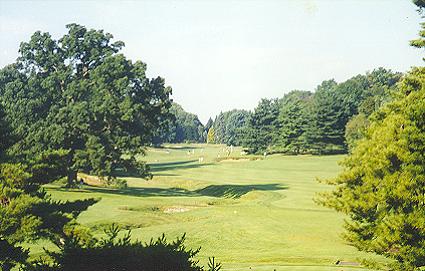
Five at Merion from the new 470 yard tee.
- Pine Valley 427 Yards Par 4
- Stonewall 375 Yards Par 4
- Philadelphia CC 544 Yards Par 5
- Merion West 203 Yards Par 3
- Merion East 468 Yards Par 4
- Stonewall 446 Yards Par 4
- Aronimink GC 384 Yards Par 4
- Manufacturers CC 117 Yards Par 3
- Merion West 429 Yards Par 4
- Lancaster CC 454 Yards Par 4
- Aronimink GC 410 Yards Par 4
- Inniscrone GC 472 Yards Par 4
- Rolling Green 434 Yards Par 4
- Rolling Green 203 Yards Par 3
- Pine Valley 591 Yards Par 5
- Merion East 428 Yards Par 4
- Gulph Mills 211 Yards Par 3
- Philadelphia Cricket 472 Yards Par 4
Total 7068 Yards Par 70
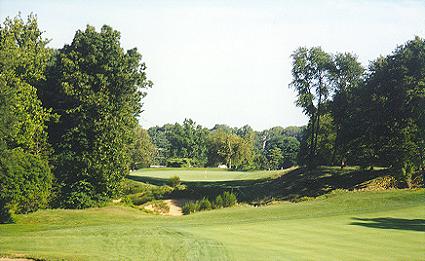
The all-world sixteenth at Merion.
9. What course is a personal favorite with which perhaps the readers may not be familiar? What do you like about it so much?
We are currently working on a restoration of the golf course for Fenway Golf club, in Scarsdale, New York. It really is an amazing course, with perhaps the most eccentric set of Tillinghast greens I have ever seen. The history of golf at this club is indeed an interesting one. It was founded on the estate of James Fenimore Cooper in 1922, and Devereux Emmet designed the original course for the Fenimore Country Club. Two years later, they closed the Emmet course, and turned the land over to Tillinghast. We were unable to find any reasons, explanations, or evidence as to why they would close the course after only two years. However, Tillinghast was fresh from a couple of successes just down the street at Winged Foot and Quaker Ridge and perhaps the club just had to have the ‘hot architect’. For whatever reason, they got quite a golf course.
The course has some wonderful rolling ground, a few rock outcroppings, and a great variety of golf holes. Tillinghast used the ground magnificently and the round of golf incorporates all facets of the game. However, it is the green complexes that make this course so special. As mentioned before, they are an eccentric bunch, featuring some of the most incredible raised plateau greens, and deep bunkers. They range in variety from the roller coaster 3rd, to the fiendishly sloping 7th. In size the 18th green is well over 10,000 square feet, and the short par 4 15th green is barely 2500 square feet. This variety is a great asset, but it is truly the putting contours themselves that merit a close study to appreciate the fine art of green construction. Our work is nearly complete, as we have restored all of the bunkers on the course, including the Sahara complex on the 3rd. We have also expanded the greens back out to their original sizes, some of which had shrunk by nearly 30% in size.
This course should be better known, and we are hopeful that some of you will put it on your travel itinerary when visiting the New York area, I think you will be very pleasantly surprised by the design Mr. Tillinghast conjured up here.
10. Which five courses possess the most fascinating green complexes?
- Pinehurst #2
- National Golf Links
- Merion – East
- Crystal Downs
- Fenway Golf Club
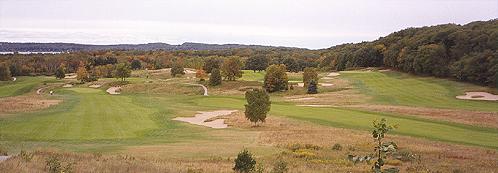
Beware the greens at Crystal Downs.
11. How do you think this period in course architecture (1985-1999) will be viewed in 50 years time?
With all of the activity in the business during this period, one would hope that it could have been another golden age. Unfortunately, this did not occur, instead a production line mentality seems to have taken hold, with the ‘top’ designers cranking out course after course. With so many courses being built, and with fees going through the roof, most designers decided to capitalize on this era, considering their bank accounts above their legacy. With this mentality in force, it would be awfully difficult to produce anything original or exciting. I think that the focus on quantity rather than quality will ultimately cast this as an era of missed opportunities. There have certainly been some great sites for architects to build courses on during this period. However, with a few notable exceptions (Sand Hills, High Pointe, etc.) the architect was not on site enough to take advantage of these great opportunities.
12. You have a project on the West Coast with Geoff Shackelford and one on the East Coast with George Bahto. Tell us about the prospects and key features of each site.
We have decided as a firm to open up a branch for wayward writers. They may have great ideas, but we need to teach them how to build great courses in the dirt. In all truth, we were presented with opportunities where we could collaborate with these two talented guys, and we were happy to do so. We enjoy collaborating with others on our projects, actually our entire firm is one big collaboration with Rodney Hine, Jim Wagner, Bill Kittleman and I working together on our projects. I certainly have not figured out all of the secrets of this art, and I enjoy having others to share ideas with, and to hopefully pool our resources to come up with creative ideas and solutions on our projects.
Tom Paul has certainly talked a lot about the merits of collaborative efforts in helping our cause for traditional course architecture. With Geoff and George, we are hoping to play a small role in moving this forward. We all know about the collaborations that produced Pine Valley, Pebble Beach, and the collaborations that Dr. Mackenzie had in his career. I am not trying to say that we will approach anything like the work that these efforts produced, however, we think that our joint efforts will produce more interesting work, and it certainly is fun working with people whom you respect and whose company you enjoy.
George chronicled our project together, which he has completed, in his interview. In 1994, we took on the task of re-routing a course on the grounds of the old Hauppaugue CC on Long Island. We also had to provide room for a considerable amount of housing. The final result was an interesting routing, however, it was extremely tight and very short. In order to try and build something that would be creative and fun to play, we came up with the idea of replicating an old Long Island course, a la The Links Club. After years of delays, the project gathered some steam, and we had already committed to two other projects, so we could not carry out the construction work. I had been talking with George about the project for awhile, and we developed the idea of creating a course that would feature holes from the Macdonald/Raynor ensemble. One thing led to another, and George made some changes to the routing, and fit in the entire cast of characters. From this point, George took over, and oversaw the construction of the course. I really think it will be a fun place to play, and for students of course architecture it will offer an amazing display of Macdonald and Raynor’s work. This is definitely a George Bahto course, we laid the framework, but he gave it life.

The Moorpark property is full of interest; the first green will be near the stake.
As for our west coast endeavors, we have a wonderful piece of ground to work with North of Los Angeles in the town of Moorpark. The course lies in a canyon with a tremendous dry wash running through the middle of the property. Geoff thinks that the land is eerily reminiscent of what Riviera looked like before Captain Thomas created his masterpiece. The routing for the course was a joint effort, with Geoff providing a lot of the details through his numerous site visits. We plan to start construction in late Summer, with an opening sometime in 2001. I am really excited about the prospects of this course, the land is really unbelievable. We will move about 30,000 cubic yards in total with most of that being at the greens and tees. We have incorporated the wash in a number of ways, and have tried hard to build interesting holes with numerous variations on play. With the quality of the land, the overall setting, and Geoff’s deep knowledge of architecture we think this will be a terrific collaboration. We would love to have anybody drop by during construction for thoughts and comments, between Geoff and I we should have the project covered nearly every day.
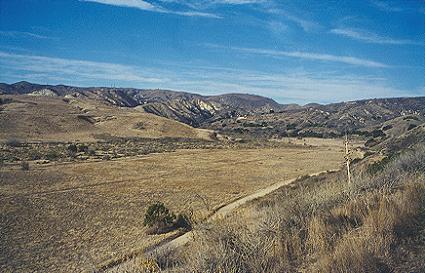
The canyon that the back nine will sit at Moorpark.
13. Why doesn’t William Flynn get more credit as a top architect?
I really am not sure why he is not better known. He certainly built some wonderful golf courses, especially here in Philadelphia. The only reason that I can think of is that he was not a flamboyant character, and his courses resembled his conservative demeanor. He was a genius at laying out golf courses, and I believe that is his strongest suit. I would defy you to find a Flynn course that is not wonderfully routed, and full of solid golf holes. Perhaps that is the problem, a career marked by many excellent golf courses, but few spectacular ones. I think that the fact that Shinnecock Hills is viewed more as an evolution of a design, rather than as a Flynn design, denies him the opportunity to ‘claim’ one of the greatest courses in the world as his own. If Shinnecock were more widely regarded as a Flynn design, then I believe his legacy would be greatly improved.
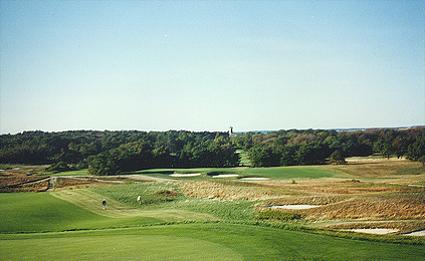
Shinnecock is Flynn's undisputed masterpiece.
14. What five courses make the player ‘think’ the most?
- Old Course – especially the more you get to know it.
- Riviera
- Merion
- Pine Valley
- National Golf Links
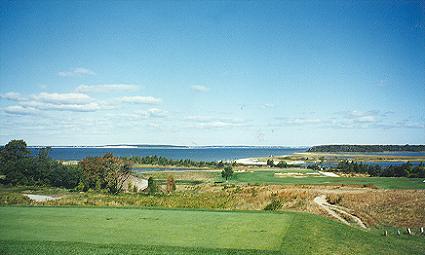
The correct way to play the seventeenth hole at the National varies from day to day.
15. What five courses are ‘must sees’ for students of golf course design?
- Old Course – to truly understand the impact natural terrain has.
- National Golf Links – for scale and imagination.
- Pine Valley – design balance and rugged beauty.
- Cypress Point – the most perfect blend of art and architecture.
- North Berwick – to learn not to place limits on creativity.
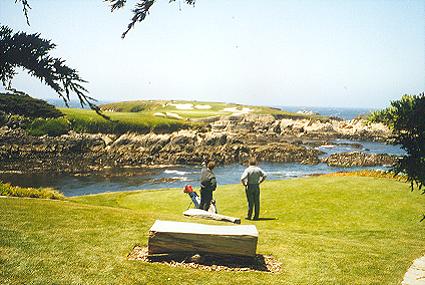
Cypress Point - the perfect blend.
16. Your ‘restoration Master Plans’ at Gulph Mills and Kittansett have been very well received. Can you tell us how far you think it reasonable to go to bring back features and concepts that may now be viewed as obsolete i.e.: ‘top shot’ bunkers, berms, dramatically raised greens etc.?
I think that the restoration of any classic courses should not be constrained in any way by what is considered reasonable in this day and age. I think that the true charm and character of these courses can often be found in what has been removed or altered from the original design. Most often the reason that these features have been removed is that they were considered unfair or obsolete. It is our contention that what is often considered unfair by the mainstream member, is the very stuff that you want to reintroduce. Because these features must have had a very real influence on the playability of the golf course for them to be so controversial. The fact that someone had to think about a feature is what every architect should be striving toward.
So often these courses have been emasculated through the removal of ‘controversial’ features, and then tree lined so that the destruction of any form of recovery or angle of attack is removed from the course. In essence, golf on many of these courses has been reduced to hit it in play or in the trees. If you hit it in play, it would be unfair to have anything in front of you i.e., cross bunkers, berms, or a natural feature that obscured your view. If you hit it in the trees, you really don’t deserve a chance at recovery, so chip it out sideways. I truly believe that the introduction of way too many trees and the eradication of classic features have seriously eroded the quality of these old courses. The beauty of many of these courses is that the architect set the course up to make recovery shots more difficult, through the angling of a green, the locations of bunkers, etc. Difficult, yet not impossible as it is from the tree lined courses of today.
Sorry for the rant, however, we find that the issues discussed above are what are truly needed to restore these courses. Fortunately, we found a membership that was supportive at Kittansett, and they made the tough decisions to truly restore the course. We cleared hundreds of trees off the course, and Jim Wagner and I restored all of the bunkers, including several cross bunkers that had been removed. We even went so far as to leave rocks and moss, in the faces of bunkers, as they had evolved in that fashion. Little touches like these keep the timeless, rustic beauty of the course and although they did not suit the clean up police.
As for Gulph Mills, the same can be said for the membership in that they have been very supportive of the proposed tree removal and the restoration of some of the antiquated features on the course. We have been selective in where we are proposing to restore some of the ‘top shot’ bunkers, as we did not want them to become a repetitive feature. However, we felt that it was important to restore most of them in order to identify this course as a true classic as well as restoring the work of Mr. Ross.
17. What single attribute of Merion impresses you the most? What work have you specifically done there?
The first part of this question is really tough, in that there are so many attributes of Merion that impress me, it is hard to get it down to just one. However, in the spirit of sticking to the questions, I think it would have to be the perfect routing for this particular piece of ground. If you walk that golf course over and over, I think you would be hard pressed to figure out a better way to lay 18 holes on such a tight piece of ground. The genius in the routing is that Wilson through convention out the window, and built the best course possible. By convention I mean that the nines are not balanced, the last par 5 on the course occurs at the 4th, and the Ninth hole is well away from the clubhouse. The balance of golf holes, variety, interesting use of the landscape, and the constant motion of the routing are all keys to the success of the course.
Once you cross Ardmore Avenue, the boundaries are on the right side of the holes, on the clubhouse side, the boundaries are to the left. His use of the quarry to figure in a different fashion on the three finishing holes was also a great use of the features at his disposal. I truly feel that Wilson achieved perfection in his creation of the East Course due to the stellar routing of the course. Other attributes that come to mind; great bunkering, interesting greens, and a feel that is unlike any other course that I know of.
At Merion we have been fortunate to be involved in the restoration of the bunkers on the following holes: 3, 7, 9, 12, 13, and 17. Jim Wagner was our man on site, and his shaping was spot on. All of the details were as seen through the eyes of Bill Kittleman and his immense knowledge of the course. The three of us spent many hours with shovels in hand, knowing that it would only be through hand work and attention to detail that we would be successful in preserving the intricacies of these bunkers. We have also prepared a tee report for the lengthening of the course, which was done in anticipation of the US Open returning to Merion. We labored with the question of lengthening the course and finally decided that we would do so only on holes where we could maintain the original line or angle of play.
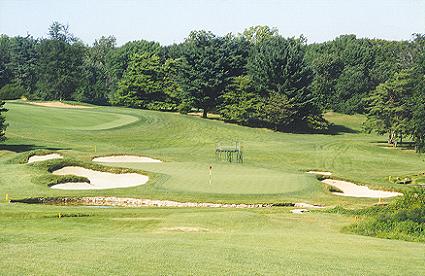
The restored bunkers on the ninth tee.
We personally constructed the new tees on the 5th and 18th Holes, and the club has decided to go it alone on building some of the other tees, most recently 3 and 6. As for the greens project, we only consulted on the expansion of the greens on Holes 3 and 6, the rest of the project was done very well by Paul Latshaw, Jr. who was the superintendent at the time.
18. At Inniscrone, your first solo American design, you used several design features that are rarely used in modern design such as a very short drop shot one shotter, blindness, split fairway, ‘line of charm’ with bunkering in the middle of the 15th fairway, etc. Please tell us how such features were initially received vs. how they are received today.
I had a person I respect give me an interesting critique of Inniscrone the other day, and this question may have driven the point home a bit. His review was that there are many features and holes at Inniscrone that were some of the best work he had ever seen. However, he said there are some places on the course where he felt that we over did it, trying to jam too many things into one golf course. He chalked it up to youthful exuberance and felt that with more maturity we would learn to be more judicious in inserting features. I think his critique is right on the money, however, I would like to receive more input on the course from the DG members and can arrange for any of you to play the course in the coming year.
As for the course, we did try to incorporate a lot of the design features that we have observed and respected over the years. We also felt that we needed to respond to the dramatic landscape with some dramatic features and golf holes. I believe that the response has been about what we expected. At first glance a lot of people don’t get some of the holes because the way to play them is not readily apparent. However, after playing the course several times, the response has been tremendous. This is something that we are quite pleased with, as it was our goal to build a course that the members would love playing over and over again. If a course loses interest or is readily deciphered after one round, it does not strike us as the type of course that would challenge and entertain a member over a long period of time.
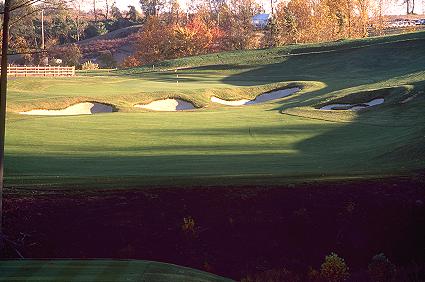
I suppose that the first ‘test’ came last May when the local PGA Section had a tournament at the course. I would have to say that 90% of the pros left the course shaking their heads. I was really pretty depressed about the response until I found out that 8 of the Top 10 finishers in the tournament took caddies, and I also sat down and read Dr. Mackenzie’s short treatise on Cypress Point in The Spirit of St. Andrews. In it he said that he was disturbed that the holes were not torn to pieces and with the lack of criticism that the course had received. He felt that it was a tribute to have a course criticized due to the subtleties and strategies that were not readily apparent after a first look. His belief that a true understanding of a course could only be gleaned after playing the course on numerous occasions and by studying it intently. This led me to believe that maybe we had created something pretty special.
I guess to sum up the question, the course is receiving more and more favorable comments, and we are terribly proud of the course. We think it holds true to most of the principles espoused on this web site. I also think that it holds to the principles discussed in earlier questions of character, interest and fun. While we were building it Bill Kittleman, Jim Wagner, and I spent a lot of time trying to incorporate the features mentioned above, and I know that the members are becoming quite fond of the interest that these features provide.
The End








